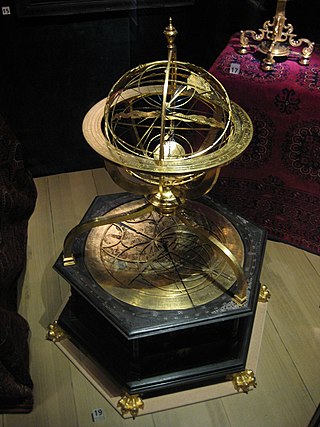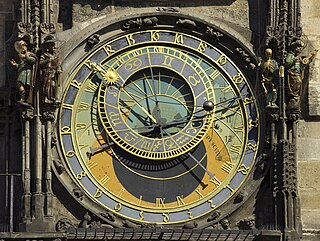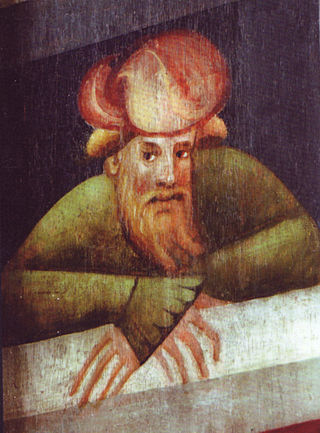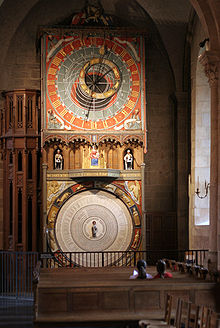
In astronomy, the new moon is the first lunar phase, when the Moon and Sun have the same ecliptic longitude. At this phase, the lunar disk is not visible to the naked eye, except when it is silhouetted against the Sun during a solar eclipse.

The Antikythera mechanism is an Ancient Greek hand-powered orrery, described as the oldest known example of an analogue computer used to predict astronomical positions and eclipses decades in advance. It could also be used to track the four-year cycle of athletic games which was similar to an Olympiad, the cycle of the ancient Olympic Games.

An armillary sphere is a model of objects in the sky, consisting of a spherical framework of rings, centered on Earth or the Sun, that represent lines of celestial longitude and latitude and other astronomically important features, such as the ecliptic. As such, it differs from a celestial globe, which is a smooth sphere whose principal purpose is to map the constellations. It was invented separately first in ancient China during the 4th century BC and ancient Greece during the 3rd century BC, with later uses in the Islamic world and Medieval Europe.

Lund Cathedral is a cathedral of the Lutheran Church of Sweden in Lund, Scania, Sweden. It is the seat of the Bishop of Lund and the main church of the Diocese of Lund. It was built as the Catholic cathedral of the archiepiscopal see of all the Nordic countries, dedicated to Saint Lawrence. It is one of the oldest stone buildings still in use in Sweden.

The Prague astronomical clock or Prague Orloj is a medieval astronomical clock attached to the Old Town Hall in Prague, the capital of the Czech Republic.

An astronomical clock, horologium, or orloj is a clock with special mechanisms and dials to display astronomical information, such as the relative positions of the Sun, Moon, zodiacal constellations, and sometimes major planets.

Rasmus Jonassen Sørnes, was a Norwegian inventor, clockmaker and radio technician, and is most famous for his advanced astronomical clocks, the most precise of which has an inaccuracy of 7 seconds during 1000 years. During his lifetime, Sørnes also designed and built a large variety of agricultural, radio-technical and mechanical devices, only a few of them patented.

Egyptian astronomy began in prehistoric times, in the Predynastic Period. In the 5th millennium BCE, the stone circles at Nabta Playa may have made use of astronomical alignments. By the time the historical Dynastic Period began in the 3rd millennium BCE, the 365 day period of the Egyptian calendar was already in use, and the observation of stars was important in determining the annual flooding of the Nile.
An ecclesiastical full moon is formally the 14th day of the ecclesiastical lunar month in an ecclesiastical lunar calendar. The ecclesiastical lunar calendar spans the year with lunar months of 30 and 29 days which are intended to approximate the observed phases of the Moon. Since a true synodic month has a length that can vary from about 29.27 to 29.83 days, the moment of astronomical opposition tends to be roughly 14.75 days after the previous conjunction of the Sun and Moon. The ecclesiastical full moons of the Gregorian lunar calendar tend to agree with the dates of astronomical opposition, referred to a day beginning at midnight at 0 degrees longitude, to within a day or so. However, the astronomical opposition happens at a single moment for the entire Earth: The hour and day at which the opposition is measured as having taken place will vary with longitude. In the ecclesiastical calendar, the 14th day of the lunar month, reckoned in local time, is considered the day of the full moon at each longitude.

Växjö Cathedral is a cathedral in Växjö, Sweden. It is the seat of the Bishop of Växjö within the Church of Sweden. According to legend, the cathedral was founded by Saint Sigfrid of Sweden. The first stone church on the site, parts of which are incorporated into the current cathedral, was built in the 1160s. The cathedral has been much altered over time, and its appearance today is largely the result of a far-reaching restoration carried out in the 1950s under the guidance of architect Kurt von Schmalensee. Växjö Cathedral is a hall church with a western tower and a square choir. It was built on a location which was probably used as a marketplace during pre-Christian times. Very few of the cathedral's furnishings have survived from earlier centuries; most of the works of art adorning the cathedral date from the 20th or 21st centuries and many of them are made of glass.

Visby Cathedral, formally Visby Saint Mary's Cathedral is a cathedral within the Church of Sweden, seat of the Bishop of Visby. It lies in the centre of Visby, the main town on the Swedish island Gotland. It was built as the church of the German traders in the city during the 13th century. The very first church was probably a wooden church, which was later replaced by a stone building. Originally built as a basilica, it was successively expanded and rebuilt during the Middle Ages. At the end of this period it had been transformed to a hall church, which it still is. In 1361, Gotland and the church became part of Denmark. Following the Reformation, it was the only medieval church in the city left in use, and in 1572 raised to the status of cathedral. Since 1645 Gotland and the cathedral have been part of Sweden. A major renovation was carried out in 1899–1903 under the guidance of architect Axel Haig.

Hampton Court astronomical clock is a sixteenth-century astronomical clock in Hampton Court Palace.

The Exeter Cathedral Astronomical Clock is a fifteenth-century astronomical clock in Exeter Cathedral, England. It displays the hour of the day, the day of the lunar month and the phase of the moon. The modern clock mechanism was installed in 1885 by Gillett & Bland of Croydon, and restored in 1910.

The 14th-century Norwich Cathedral astronomical clock was the earliest example of a large clock with automata in England, and the first to possess an astronomical dial. It replaced an earlier 13th-century "old clock", one of the earliest weight-driven mechanical timekeepers made in England.

Östra Vemmerlöv Church is a medieval church in Östra Vemmerlöv, in the province of Skåne, Sweden. It belongs to the Diocese of Lund. It contains many medieval mural paintings.

A computus clock is a clock equipped with a mechanism that automatically calculates and displays, or helps determine, the date of Easter. A computus watch carries out the same function.

Necrologium Lundense is a 12th-century illuminated manuscript probably made in Lund to serve as a book of rules for the canons of Lund Cathedral, with texts used by them in their daily life. Its oldest parts date from around 1123, and it is considered the oldest still intact manuscript written in Scandinavia. It is preserved in a late medieval binding and the text is partially adorned with decorated initials, including one which displays influences from Viking art. The book is today kept in the University Library of Lund University.

Nikolaus Lilienfeld was a German engineer and clockmaker of the late 14th and early 15th centuries.

The Münster astronomical clock is an astronomical clock in Münster Cathedral in Münster, Germany.
The Bourges astronomical clock is an astronomical clock in Bourges Cathedral in Bourges, France.
























